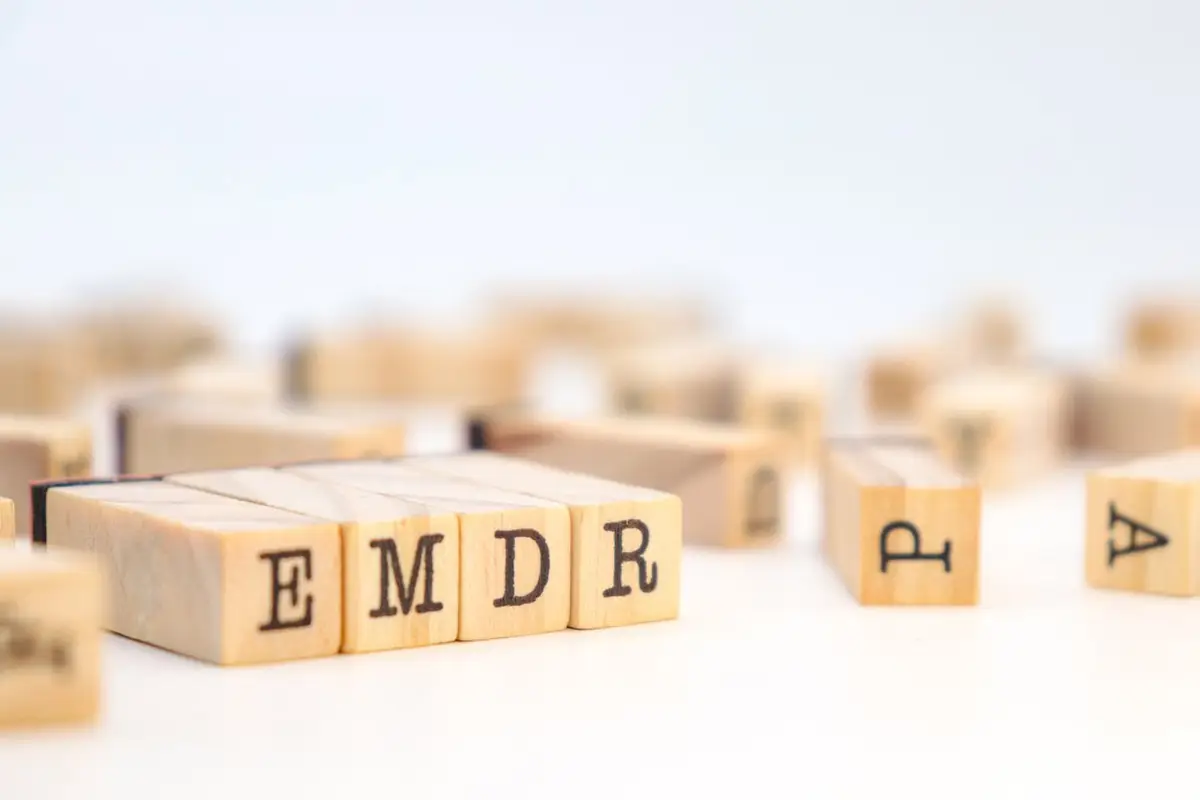October 10, 2023, is World Mental Health Day.
Nearly every morning it’s the same thing. I’m jolted awake from a dream about my father. In the dream, it’s come to light that he isn’t dead. His death was a hoax. Still blurry from sleep, I try to make sense of this news. Then it all comes flooding back: the way he gasped and writhed, the way the machines beeped and hummed, the way the guards (my father died incarcerated) glanced up, annoyed, while texting, interrupted by my wailing sobs.
It’s been close to three years since my dad died, but in these waking moments, it’s as though I’ve lost him just minutes ago.
I want this memory to stop hurting me. But I also don’t want to forget my final moments with my father. What can I do? I may have found the answer: EMDR therapy.
Recently, I’ve been hearing more about EMDR, which stands for eye movement desensitization and reprocessing. This is likely because celebrities such as Miley Cyrus and Prince Harry have been publicly sharing their transformative experiences with EMDR, which is endorsed by the World Health Organization, the National Alliance on Mental Illness, the Department of Veterans Affairs and the American Psychological Association.
So what exactly is EMDR? And can it benefit people like me who feel trapped in time by traumatic memories?
What is EMDR?
Developed in 1987 by Francine Shapiro, Ph.D., EMDR is a structured therapy designed to treat trauma. During a session, the patient focuses briefly on a trauma memory while, at the same time, experiencing stimulation to both sides of the brain. (This can be done through eye movements, but there are other methods, such as tapping and sounds.)
The goal of this therapy, which is provided by an EMDR-trained specialist, is for the person to feel a reduction in the vividness and emotion associated with the trauma memory.
Read: Childhood Trauma Can Lead to Chronic Pain >>
It may sound like magic, but this is deeply scientific stuff. EMDR activates different parts of your brain — including your amygdala (processing emotions) and hippocampus (memory and learning) — to allow for reprocessing a memory so it’s no longer upsetting. It’s not just what you want, either — it’s what your brain needs and is designed to do.
“EMDR revolves around the brain’s ability to heal itself when processing traumatic memories,” said Arielle Jordan, an EMDR therapist who has found EMDR to be life-changing in her journey with post traumatic stress disorder (PTSD) and grief. “It leads to more adaptive information, which is what your brain is looking for anyway — but you may need that third party [of EMDR] to assist.”
What happens in EMDR sessions?
According to the EMDR International Association, there are eight phases of EMDR therapy, which occur over a number of sessions, with each session usually lasting about an hour (though some clinicians offer intensive sessions that can last many hours).
The eight phases of EMDR are:
- Comprehensive history taking: Discussion of goals and building a foundation of trust with your therapist.
- Preparation: Education on EMDR. The therapist explains specific techniques and makes sure you are prepared emotionally for reprocessing.
- Assessment: Identification of and activation of a trauma memory.
- Desensitization: Following your therapist’s cues — whether it’s finger movements, tapping or sounds — to reprocess the target memory until it is no longer distressing.
- Installation: Replacement of negative beliefs with positive ones about the event.
- Body scan: Guidance in a mindfulness, grounding or relaxation technique by the therapist to ensure that you can conjure the target event without feeling tension in the body.
- Closure: Check-in at the end of each session to make sure you leave feeling better at the end of the session than at the beginning.
- Reevaluation: Evaluation at the beginning of each session of whether you need to continue processing the memory you worked on in the previous session or move to a new memory.
With EMDR, you don’t wipe out the traumatic memory entirely. Instead, you become desensitized to it so that it fails to muster anger, sorrow, fear, panic or any of the other upsetting emotions or thoughts it used to trigger.
The EMDR process can also make room for better memories surrounding the trauma. This makes it particularly useful if you’re dealing with a grief memory and don’t want to forget anything about the person you lost, but just want to feel a weight off when you think about how you lost them, or other negative events surrounding the trauma. This is a motivating factor for me, as I want to remember everything about my dad, but painlessly.
Who can benefit from EMDR?
Anyone who has experienced trauma may benefit from EMDR therapy — especially women.
Research shows that EMDR therapy can treat conditions that affect more women and people assigned female at birth (AFAB) than men, including PTSD, eating disorders, depression and anxiety disorders. Studies also show that EMDR therapy can help survivors of sexual assault process and recover from trauma.
If you have a number of unique traumatic memories, you can work through and reprocess each of them in separate sessions.
What are possible risks of EMDR?
One risk with EMDR is the possibility of dissociation — a state where you feel disconnected from yourself, body and mind. Your therapist will try to assess the chances of this occurring when taking your history and determining if you’re a good candidate. They will also stabilize you, as needed, throughout the session.
During an EMDR session (and even for hours after, sometimes), your brain is doing a lot of intense work and you’ll likely experience some difficult emotions. This often leads to fatigue after sessions. Never plan an EMDR session when you have something to do afterward, like on your lunch break, and always make some time after for rest and self-care.
Who should not do EMDR?
It’s critical to be assessed by your therapist (this happens during the history-taking portion of your early sessions) and, if you have any medical conditions, by your primary care physician, too.
Because of the aforementioned risk of dissociation, people with certain mental health conditions may not be a fit for EMDR. “Someone who may experience psychotic symptoms, or is living with schizophrenia, or with a mood disorder like bipolar may not be the best fit for EMDR,” said Kiva Harper, an EMDR therapist.
If you already have a condition or are on medications that can cause dissociation, EMDR may be a dangerous trigger and should be avoided.
In addition to mental health or medical conditions, you may want to postpone EMDR therapy if you need the vividness and pain of the traumatic memory for legal purposes.
“When working with victims of crime, sometimes they have to be a witness in court,” Harper said. “A lot of times, attorneys don’t want them to be desensitized on the stand. We may consult with attorneys to discuss if the patient can do EMDR.”
What are the barriers to accessing EMDR therapy?
EMDR therapy isn’t as widely accessible as talk therapy because there just aren’t as many clinicians practicing it. And there are some common barriers. For example, many EMDR providers do not take health insurance. Additionally, the space is still predominantly white (in terms of practitioners), which can present challenges for people of color who want to work with someone of a specific race or ethnicity.
How can you find an EMDR therapist?
If you’re interested in EMDR therapy, you can search for therapists on the EMDR International Association website.
“Their therapists are properly trained,” Jordan said. “You can enter your insurance and it will find someone in your area, if available, who takes your insurance.”
You can also call your insurance provider and have them send you a list of therapists.
“[The insurance provider list] won’t list who specializes in EMDR, but you can then do a Google search and see if they have that skill,” Jordan said.
I’m so relieved to know this treatment exists, and I’m on the hunt for an EMDR therapist in my area. I can’t wait to begin.
If you or someone you know is having a mental health crisis, please call or text the Suicide and Crisis Lifeline at 988.
- What Is Art Therapy and How Can It Help Women? ›
- Good Sex with Emily Jamea: Healing After Sexual Assault ›
- Mental Health 2023 - HealthyWomen ›
- EMDR Therapy Helped Me Heal from Trauma. Now I Use it to Help My Clients. ›
- You Can't Put a Band-Aid Over a Bullet Hole: How I Healed From Sexual Trauma and Substance Abuse - HealthyWomen ›







